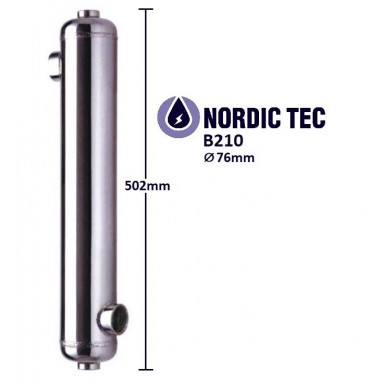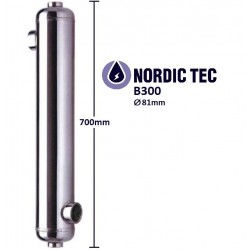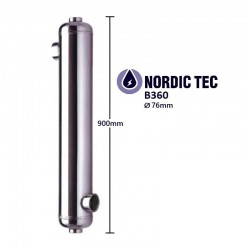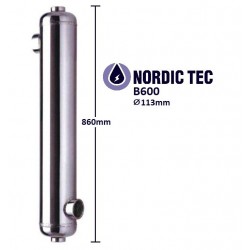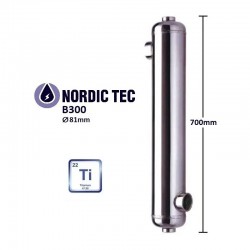POOL HEAT EXCHANGER NORDIC B210 61KW (210KBTU/H)
Swimming Pool Heating - Heat Exchanger B210 61 kW
- Swimming Pool Heat Exchanger with wall-mounting brackets
- Nominal Capacity: 61kW
- based on 60 °C difference between heating and heated medium (water to water), with counter-courent work
- Material: Stainless steel 3
- Heat Exchange surface: 0.44 m²
- Connections: 2x 1 1/2" & 2x 1 1/2"
Heating device - heat exchanger for swimming pool heating, made of stainless steel resistant to high chlorine concentrations and swimming pool chemicals used for water treatment. The device type is a tube heat exchanger (or shell and tube).
Nordic Tec pool heat exchangers can work with most heat sources available on the European market - such as heat pumps, gas boilers, water-jacketed fireplaces, and others. It is also permissible to use the heat exchanger as a component for swimming pool heating using glycol-filled solar collectors. Glycol does not make any risk to our device.
☑️ Delivery possible in every European country
✅ Free delivery in: FR, IT, ES, DE, PL, SI, AT, DK, NL, BE, CZ, LV, EE, LT
Reference: B210
Condition New
61 kW Pool Heat Exchanger Nordic Tec B210
61 kW shell and tube heat exchanger for pool heating.
One of the most popular pool heat exchanger models, appreciated for its classic dimensions and performance.
Rated power: 61 kW (210 kBTU/h)
- The B210 pool heat exchanger achieves a rated power of 61 kW (210 kBTU/h) - when the fluids used are water/water (without the addition of glycol or other antifreeze liquids) and the temperature difference between the two sides is 60 °C. However, this does not imply that the pool heat exchanger can achieve 61 kW with reduced supply parameters, such as those provided by a heat pump.
If the temperature difference between the heating fluid and the heated fluid decreases, the actual heat transfer capacity (measured in kW) also decreases according to the following scheme:
- for 50 °C = 85% | 51 kW
- for 40 °C = 70% | 42 kW
- for 30 °C = 55% | 33 kW - In the case of using other heating fluids with different heat transfer capacities, such as glycol, the value of 61 kW is purely indicative.
- If the use of an antifreeze liquid such as glycol is required, the heat transfer efficiency will decrease by approximately 8-15%, depending on the glycol concentration. This is an important aspect to consider when choosing a pool heat exchanger.
Material: Stainless Steel - INOX (without additives) - designed to work with chlorinated water, even highly chlorinated.
Intended use (fluids) - the B210 pool heat exchanger ✅ is designed for fresh water; use with salt-additive water or seawater is not recommended.
Nominal flows:
- Heating fluid / heat source side: 35 l/min
- Heated fluid / pool water: 242 l/min
Operating pressure: up to 6 bar - Test pressure: 10 bar
Fluid connections
- 2x 1 1/2"
- 2x 1 1/2"
Recommended pool volume:
- Up to 70 m³ nominal, maintaining a fluid temperature difference of 60°C (as indicated above) and adequate flow levels.
- It should be noted that the pool volume indicated above can only be properly managed by the B210 heat exchanger if adequate parameters are guaranteed, i.e., a heating fluid with a temperature 60°C higher than the pool water and adequate flows, as specified in the description.
- In practice, the B210 heat exchanger more frequently manages smaller pools, depending on the heat source used.
Dimensions:
- Length with water fittings: 502 mm
- Diameter: 76 mm
Heat exchange surface of the B210 pool heat exchanger - 0.44 m²
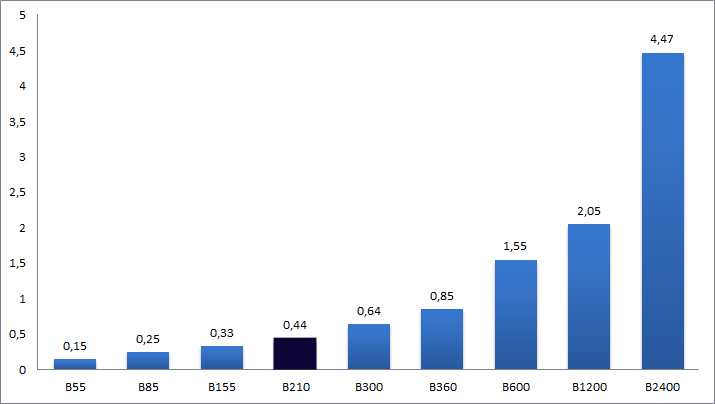
Connection method of the B210 pool heat exchanger to the heating system
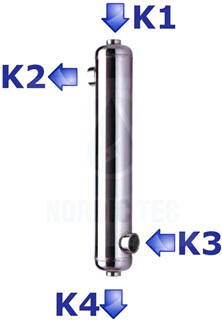
The main method for connecting the B210 pool heat exchanger is counter-current. Any other method will not guarantee optimal efficiency for pool heating. Below is a description of how the counter-current connection works, referring to the diagram above, which shows the connections of the heat exchanger.
- K1 - heating fluid inlet
- K2 - heated fluid outlet
- K3 - heated fluid inlet
- K4 - heating fluid outlet
Pool heat exchangers, including the 61kW B210 model, are connected in counter-current to achieve maximum efficiency in pool heating. The connection according to the above diagram follows the counter-current principle and it is advisable to adhere to it. Otherwise, the device will lose part of its efficiency and the pool may not reach the desired temperature.
Pool Heat Exchanger - Nordic Tec B210
Advantages of shell and tube heat exchangers over plate heat exchangers
The advantages of a pool heat exchanger (shell and tube) over plate models start with the fact that it has a much wider channel, which allows for greater flow in that channel. This larger channel is naturally intended for pool heating, while in plate heat exchangers both channels are generally of equal size. When heating a pool, it is evident that the mass flow on the pool side must be significantly greater, allowing for uniform heating of large amounts of water without introducing small amounts of hot water, which would be uncomfortable and sometimes dangerous.
In addition, pool heat exchangers generate almost no flow resistance, i.e., they have almost no pressure loss. This does not negatively affect the consumption of pool circulation pumps, while plate heat exchangers cause rather significant pressure losses, which increase with increasing flow rate.
Another aspect that makes the pool heat exchanger particularly suitable is the absence of copper welds (as in plate models). Pool heat exchangers are welded in steel and are made 100% of steel (unless it is a titanium model for salt or brackish water). Copper welds are the least resistant part to high chlorine concentrations and pool chemicals, and are usually the cause of leaks in plate heat exchangers in these applications. Moreover, most manufacturers void the warranty on plate heat exchangers if they are used with high chlorine concentration water.
Solar pool heating and the B210 pool heat exchanger
Solar pool heating is a heating system where solar panels, or solar collectors, act as the heat source to heat the pool water. During the summer, this system is very efficient, as the solar collectors placed on the roof can reach very high temperatures.
Solar pool heating has many advantages: first of all, it is a zero-cost system, requiring almost no expense, except for the purchase and installation of the solar collectors. In addition, the operation is completely automatic and requires no human intervention. For outdoor pool heating, it is an excellent solution, although it is important to correctly size the surface area of the solar panels in relation to the pool volume.
However, solar heating also has limitations, as it depends on weather conditions and reaches maximum efficiency on hot and sunny days, which paradoxically are the times when pool heating is least needed. It is a seasonal and uncontrollable heat source.
The role of the heat exchanger in solar pool heating
The solar pool heating system is powered by solar panels filled with glycol, an antifreeze fluid that prevents the collectors from freezing in winter. To prevent the glycol from mixing with the pool water, it is necessary to connect the pool heating circuit to the glycol circuit via a heat exchanger, such as the 60 kW B210 model. In this case, each circuit will have its own circulation pump. Without a heat exchanger, it is not possible to connect the two circuits without mixing them.
B210
49 Items
New
No reviews
You might also like
